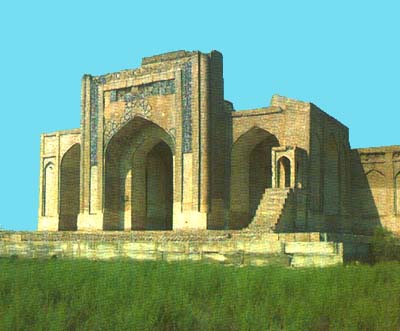It's amazing what you can find in a Soviet suburban wasteland.
Given more than the hitherto customary two days in Bukhara, hire a taxi
for half a day and take a swing round the south circular, starting just
inside it, not far from Samani Park, at the Balyand mosque. The imam will
not let Russians in; demonstrate your foreigners. It's worth it for the
lavish early 20th - century tile work in and around the mihrab, and for
the painted wood ceiling (which hides the beams of the actual roof). The
basic structure is early 16th - century, and the corner colonnade typical
for a parish mosque.
Ulitsa Ordzonokhidze leads due south to a roundabout and,
facing a wall of trellised vines on the right (west), the 17th - century
Dzubari Kalyan madrasa. This is a rare thing: a madrasa for girls, apparently
aged 16-18, on a two-year course of embroidery and the Koran. Visitors
are not allowed in. The mosque across the road beyond the vines is not
used as one but its khauz seems to be a
public water source.
 At
the next roundabout, half a mile south-east, there is a building of grandeur
and desolation: which quality dominates depends on your mood and the light.
The Namazgokh mosque was first built in 1119-20 by Arslan Khan, the Karakhanid
who built the Kalyan minaret, and some of his west wall, with precious
pre-Mongol decoration in brick, terra-cotta and stucco, survives under
the main 16th - century structure. This was a big mosque but was intended
only for special twice-yearly holiday prayers. It looks best in the evening.
At
the next roundabout, half a mile south-east, there is a building of grandeur
and desolation: which quality dominates depends on your mood and the light.
The Namazgokh mosque was first built in 1119-20 by Arslan Khan, the Karakhanid
who built the Kalyan minaret, and some of his west wall, with precious
pre-Mongol decoration in brick, terra-cotta and stucco, survives under
the main 16th - century structure. This was a big mosque but was intended
only for special twice-yearly holiday prayers. It looks best in the evening.
The Buyan Kuli Khan and Saif ed-Din mausoleum form half
of an extraordinary double act in which medieval Islam meets obsessive
20th-century industrialization. The other half is a busy railway shunting
yard south-east of the Old Town off Sholkomotalnaya Ulitsa. The Buyan Kuli
Khan mausoleum (1358), resting place of a Mongol Khan killed in that year
in Samarkand, is a rare survivor of Bukhara's long, depressed post-Mongol
resurrection. The majolica-work round its front door rivals that of Samarkand's
Shah-i-Zinda complex, and is shaken all day every day by goods trains passing
a few feet away.
The Saif-ed-Din mausoleum next door commemorates Sheikh
Saif ed-Din Bokharzi (1190-1262), a popular poet and theologian who survived
Genghis Khan's visitation and probably funded one of this district's many
khanagas for the poor and homeless. The mausoleum is roofless and so plain
that it was long thought to date from the 13th century, though in fact
it dates from the 16th. Both buildings are surrounded by huge piles of
concrete pipes.
Back on the Ring road it is a short drive north to the
handsome Faizabad Khanaga (1598-99) on Ulitsa Suleimana Muradova, which
gave traveling dervishes temporary shelter on three floors of cells. It
is normally closed but an Intourist guide may know where to get a key.
[back]

